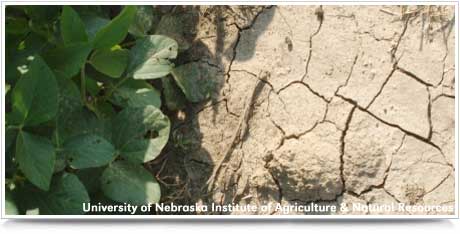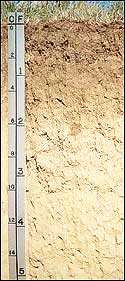
Soils are one of the most valuable assets on an acreage. They are used as a foundation for roads and buildings, a receptacle and treatment medium for waste water and a growth medium for plants. The suitability of a particular soil for a given land use is a function of its depth, texture, structure, organic matter content and slope.
Soil Depth
Limitations for selected uses due to soil depth |
|||||
< 24 inches |
24-36 inches |
36-60 inches |
60-72 inches |
> 72 inches |
|
| growing plants | severe | moderate | slight | slight | slight |
| roads | severe | moderate | slight | slight | slight |
| buildings w/o basements | severe | moderate | slight | slight | slight |
| septic absorption fields | severe | severe | moderate to severe | moderate | slight |
| sewage lagoons | severe | severe | moderate | slight | slight |
Soil depth is the thickness of soil from the surface to a root-limiting layer such as bedrock or a seasonal high water table. The degree of limitation associated with a given depth depends on the proposed use.
Soil Texture
Texture |
How does it feel? |
Available water holding capacity |
Fertility holding |
Permeability |
Clay (fine) |
Sticky |
1.0 - 1.6"/ft |
High |
Very Slow |
Loam (Medium) |
Soft/Non-Sticky |
1.8 - 2.0"/ft |
Medium |
Moderate |
Sand (Coarse) |
Gritty |
0.6 - 1.1"/ft |
Low |
Rapid |
Soil texture describes the relative amount of sand, silt and clay in a given soil and influences many other soil properties including porosity, drainage, permeability (the rate at which water moves through a soil), available water holding capacity and nutrient holding capacity. Depending on the amount of each, soils can be grouped into three broad textural classes: clay, loam or sand. You can estimate soil texture by rubbing a small amount of moist soil between your thumb and index finger.
Soil Structure
Soil structure describes the shape and size of soil aggregates and influences the size distribution of pores in soils. Approximately 50 percent of the total volume of a typical soil is pore space. These pores are either filled with water or air and the balance of air and water has a significant effect on plant growth. This balance is influenced by the relative size of the pores. Large pores are essential for drainage and aeration, while small pores store water. Although fine-textured soils have the greatest amount of total pore space, most of the pores are very small, which restricts movement of air and water. On the other hand, most of the pores in coarse-textured soils are large, which limits water holding capacity.
 Soil Organic Matter
Soil Organic Matter
Soil organic matter is essential to the development and maintenance of good soil structure, providing optimal conditions for internal drainage of water and aeration for plant growth in medium- and fine- textured soils. Organic matter also improves the water- and nutrient-holding capacity of coarse-textured soils. The organic matter content of soils is generally highest in the upper part of the soil profile and decreases with depth. Soils with high organic matter content are usually dark brown or black in color.
Soil organic matter is significantly influenced by management practices. Research has consistently shown that the best means of improving or restoring soil health and productivity is by proper and regular addition of organic materials such as compost or manure.
Percent Slope
Percent slope is the relative change in elevation measured in feet per 100 linear feet. While it is a feature of the landscape and not a soil property, it has a significant influence on soil formation and soil management. Soils with slopes greater than 3 to 5 percent often have severe runoff and soil erosion and require management practices that protect the soil surface and minimize runoff.
Most of this soil information can be found in modern soil surveys which are available for most Nebraska counties from the Natural Resources Conservation Service or the Conservation and Survey Division of the University of Nebraska. Keep in mind that soil properties can vary considerably over short distances. While soil maps are useful for determining the dominant types of soil on your acreage, a detailed evaluation of the soils may be necessary to determine its suitability for uses such as installation of a waste water treatment system.
For more information about soils and soil management, contact your local Extension office, the Natural Resources Conservation Service.
Source: Adapted for Lancaster County, Nebraska from A Place in the Country: The Acreage Owner's Guide (EC97-2506C).